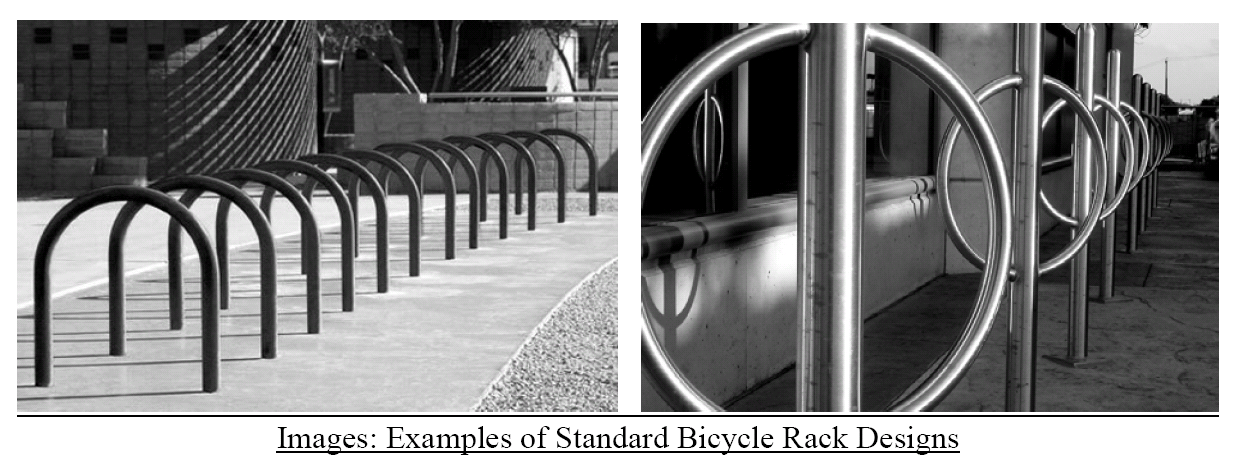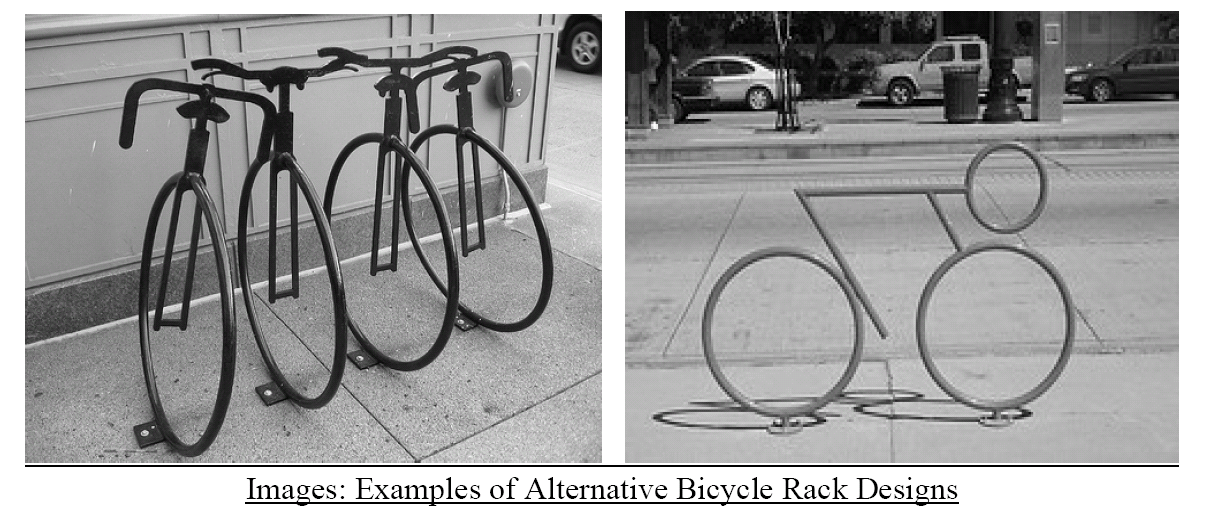 |
Orlando |
 |
Code of Ordinances |
 |
Chapter 61. ROADWAY DESIGN AND ACCESS MANAGEMENT |
 |
Part 3. PARKING AND LOADING |
 |
Appendix 3D. BICYCLE PARKING |
§ 61.335. Design.
(a)
Bicycle Parking Space Design. All bicycle parking spaces shall comply with the following standards:
(1)
Minimum aisle width: 60 inches, to allow for access and maneuvering.
(2)
Accessibility: Accessible to users without climbing or descending stairs.
(3)
Safety: Separated from vehicle parking spaces by physical barriers, such as curbs, wheel stops, bollards or other similar features, to protect bicycles from damage.
(4)
Site Coordination: Consistent with the design, color and character of the buildings, street furniture and other features on the building site, but clearly discernible as bicycle parking.
(5)
Type: Enable users to lock the frame and both wheels.
(6)
Construction: Anchored, so that they cannot be easily removed.
(7)
Distance: Bicycle racks not be placed closer than thirty (30) inches from each other and not closer than thirty-six (36) inches from walls or any other obstructions.
(8)
Style: The inverted "U" style bicycle rack that can hold two bicycles is the preferred type of rack (also known as a "staple", "hoop", or "U" rack). Bicycle racks that are prohibited in the City of Orlando are the wave, comb, schoolyard, coat hanger, wheel well, and bollard style as defined in the Association of Pedestrian and Bicycle Professionals', Essentials of Bike Parking, Rev. 1, 2015.
(b)
Standard Bicycle Rack Design. All standard bicycle racks shall comply with the following standards:
(1)
Maximum rack height: 36 inches.
(2)
Minimum depth for each row of parked bicycles: 72 inches.
(3)
Minimum tube diameter: 1.9 inches.
(4)
Minimum separation between horizontal rows: 30 inches on center to allow enough room for 2 bicycles to be secured to each rack element.
(5)
Capacity: Designed to accommodate 2 bicycle parking spaces per rack.
(6)
Finish: Powder coated, or other weather-proof surface, as approved by the Transportation Official.
(7)
Function: Supports a bicycle frame at 2 points above the wheel hubs.
(8)
Simplicity: Easy to understand and operate, with no moving parts.
(9)
Operation: Usable without lifting the bicycle onto the device. (Applies to Short-Term racks only).

(c)
Alternative Bicycle Rack Design . Alternative bicycle parking rack designs may be approved, in compliance with the following standards:
(1)
Size : Accepts multiple bicycle frame sizes and styles.
(2)
Compatibility : Accommodates the use of cable and U-type locks.
(3)
Function : Supports a bicycle frame at 2 points above the wheel hubs.
(4)
Purpose : Allows the frame and at least 1 wheel of the bicycle to be locked to the rack.
(5)
Scale : Visible to pedestrians and the visually impaired, but consistent with the scale of the bicycle locked to the device.
(6)
Durability : Maintenance-free or fabricated from materials that weather in an aesthetically pleasing manner.
(7)
Simplicity : Easy to understand and operate, with no moving parts.
(8)
Operation : Usable without lifting the bicycle onto the device.

(d)
Bicycle Lockers Design . Bicycle lockers shall comply with the following minimum standards:
(1)
Height : 49 inches.
(2)
Width : 30 inches.
(3)
Length : 74 inches.
(4)
Capacity : Accommodates 1 bicycle per locker.
(5)
Durability : Maintenance-free or fabricated from materials that weather in an aesthetically pleasing manner.
(Ord. No. 2010-33, § 1, 8-30-2010, Doc. #1008301102; Ord. No. 2019-10 , § 4, 3-25-2019, Doc. #1903251201)